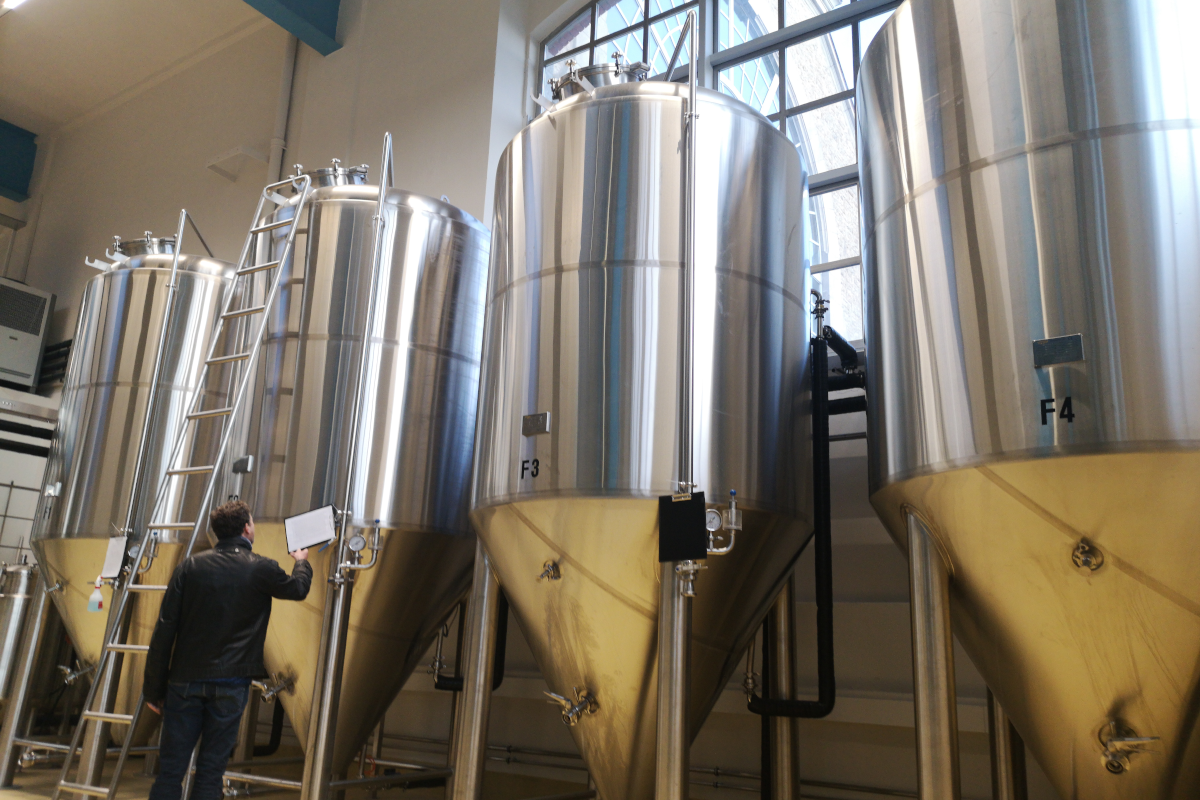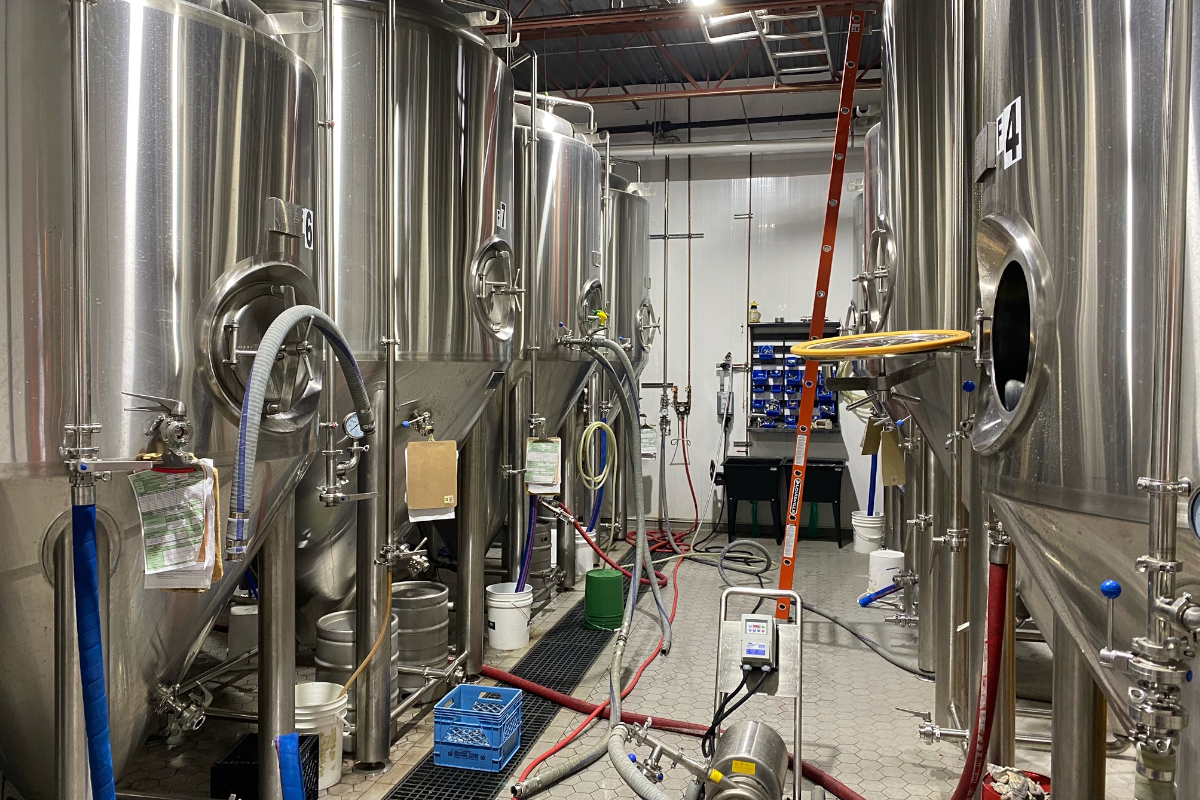
How Do You Design Fermentation Tanks?
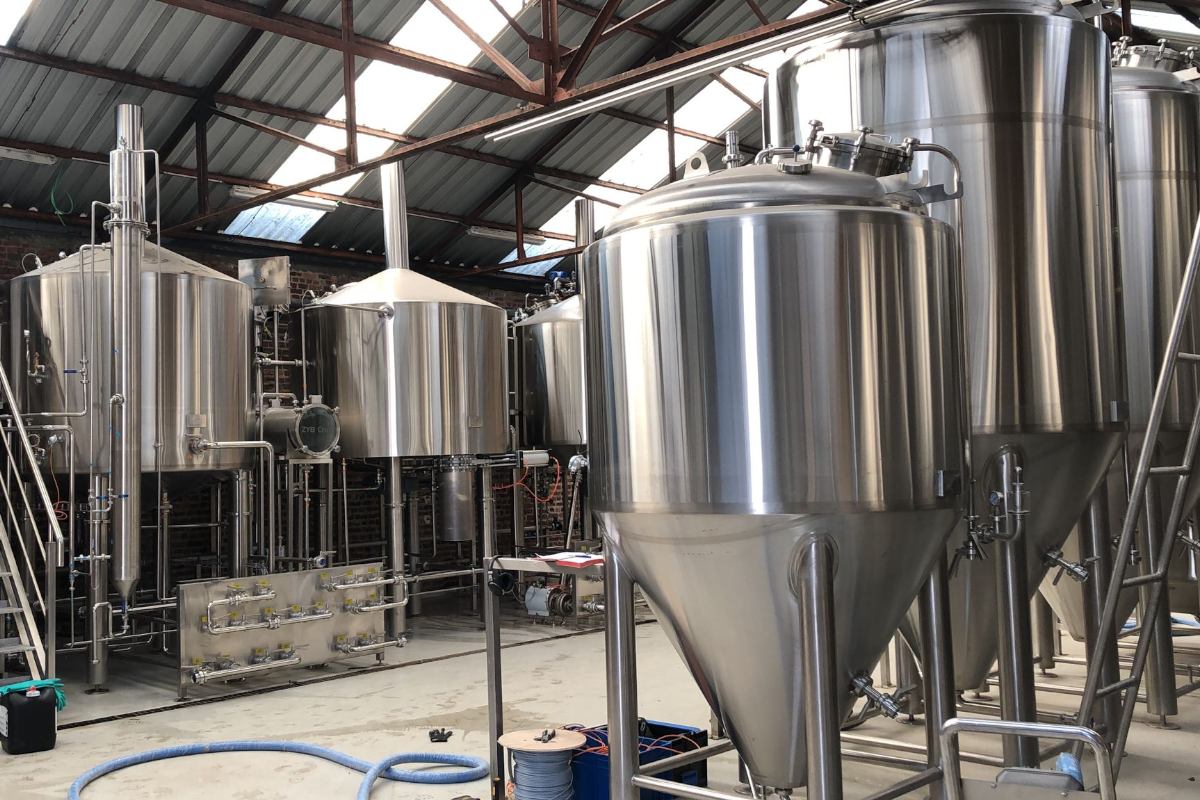
Material Selection
Stainless Steel
Stainless steel is the preferred material for fermentation tanks in the brewing industry, owing to its exceptional properties that cater to the rigorous demands of fermentation.
- Corrosion Resistance: Stainless steel is highly resistant to corrosion, especially in acidic environments typical of fermentation. This resistance helps maintain the integrity of the tank over time, reducing the need for frequent replacements.
- Durability: Stainless steel is incredibly durable, capable of withstanding high pressure, temperature fluctuations, and the physical demands of a busy brewery environment. This durability translates into a longer lifespan for the tanks.
- Ease of Cleaning and Sanitization: The smooth, non-porous surface of stainless steel is easy to clean and disinfect, which can maintain a sterile environment and prevent contamination.
- Non-reactivity: Stainless steel does not interact with the brewing ingredients, ensuring that the taste and quality of the beer remain uncompromised throughout the fermentation process.
Grades of Stainless Steel
- 304 Stainless Steel: The most common grade used in brewery tanks, 304 stainless steel offers a balance of cost and corrosion resistance. It is suitable for most fermentation processes and is known for its versatility and reliability.
- 316 Stainless Steel: This grade offers enhanced resistance to corrosion, particularly against chlorides and other harsh chemicals. It is ideal for breweries that may encounter more aggressive cleaning agents or environments with higher salinity.
Alternatives to Stainless Steel
Glass-Lined Tanks
- Advantages: Glass-lined tanks offer an inert, non-reactive surface similar to stainless steel but with the added benefit of being resistant to almost all chemicals. They are often used in situations where extremely high purity is required.
- Disadvantages: These tanks are generally more expensive and fragile compared to stainless steel, making them less suitable for high-volume, industrial brewing.
Food-Grade Plastic
- Advantages: Food-grade plastic tanks are lightweight, easy to handle, and cost-effective. They are often used in small-scale or experimental brewing.
- Disadvantages: Plastic is less durable, can absorb flavors and odors, and is prone to scratching, which can harbor bacteria and lead to contamination.
Copper
- Advantages: Copper has historical significance in brewing, particularly in distillation. It is known for its excellent heat conductivity and ability to remove sulfur compounds, improving the beer’s flavor.
- Disadvantages: Copper is prone to corrosion and requires regular maintenance. It is also more expensive and less commonly used in modern brewery fermentation tanks.
Wood
- Advantages: Wooden fermentation tanks, such as oak barrels, are used for specific beer styles, particularly those that benefit from the unique flavors imparted by the wood.
- Disadvantages: Wood is challenging to clean and sanitize, which increases the risk of contamination. It is also less durable and requires more maintenance than stainless steel.
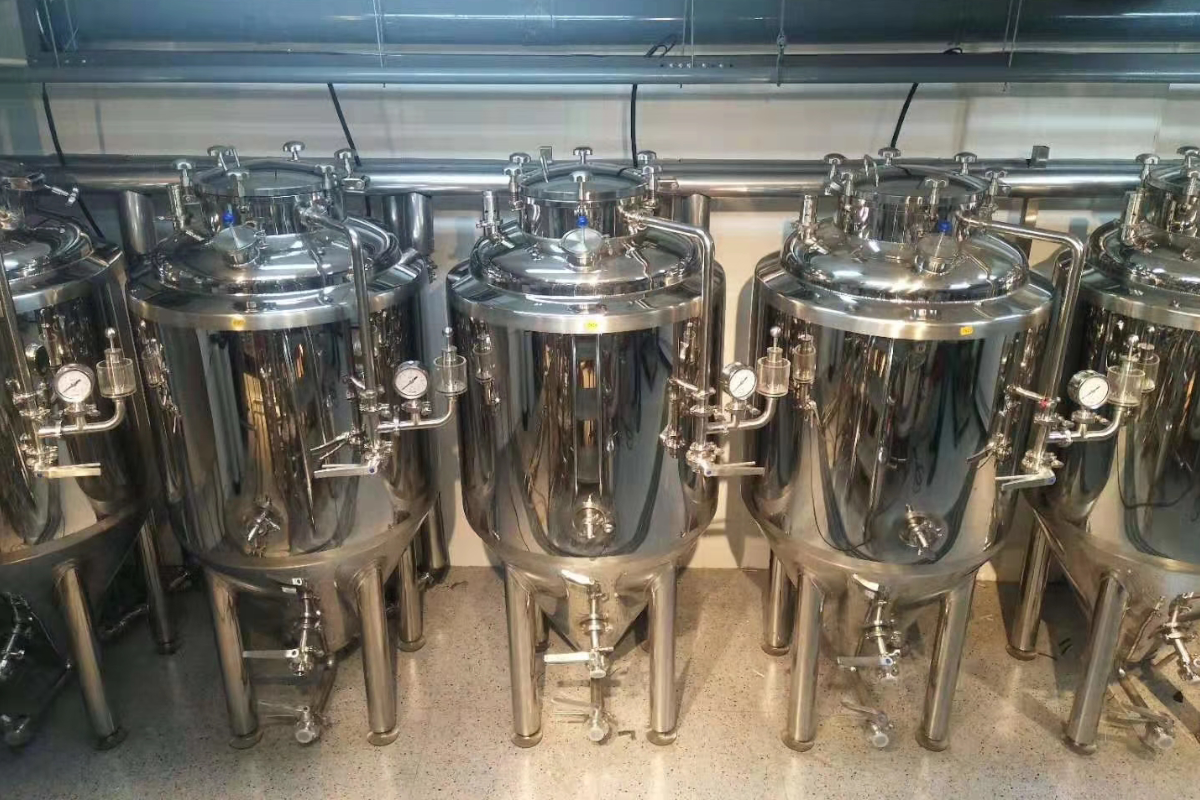
Tank Shape and Configuration
Cylindroconical Tanks
Design Features
Advantages
- Efficient Sediment Removal: The conical bottom facilitates the separation of yeast and trub (sediment) from the beer, making it easier to harvest yeast and improve clarity without disturbing the fermenting liquid.
- Optimized Fermentation: The cylindrical shape allows for better mixing and release of CO2, which helps with sustained fermentation.
- Space Efficiency: These tanks can be stacked vertically, optimizing space in the brewery.
- Scalability: Cylindroconical tanks can be easily scaled to accommodate different production volumes, making them ideal for both small and large breweries.
Applications
Horizontal Tanks
Design Features
Advantages
- Lagering: Horizontal tanks are particularly suited for lagering, where extended contact with the yeast and slower sedimentation are beneficial for flavor development.
- Improved CO2 Dissipation: The increased surface area helps in the dissipation of CO2, which can reduce pressure on the tank and result in a smoother, more refined product.
- Ease of Access: The horizontal design allows for easier access to the interior of the tank for cleaning and inspection, which can be beneficial in smaller operations.
Applications
Custom Shapes
Design Considerations
Advantages
- Flexibility: Custom-shaped tanks offer flexibility in brewery design, allowing for optimal use of available space, especially in non-standard brewery layouts.
- Specialized Processes: Custom shapes can be designed to enhance specific aspects of the fermentation process, such as mixing, temperature control, or yeast collection, depending on the brewery’s unique needs.
- Aesthetic Appeal: Custom tanks can also be designed with aesthetics in mind, offering a unique look that can become a visual centerpiece of the brewery.
Applications
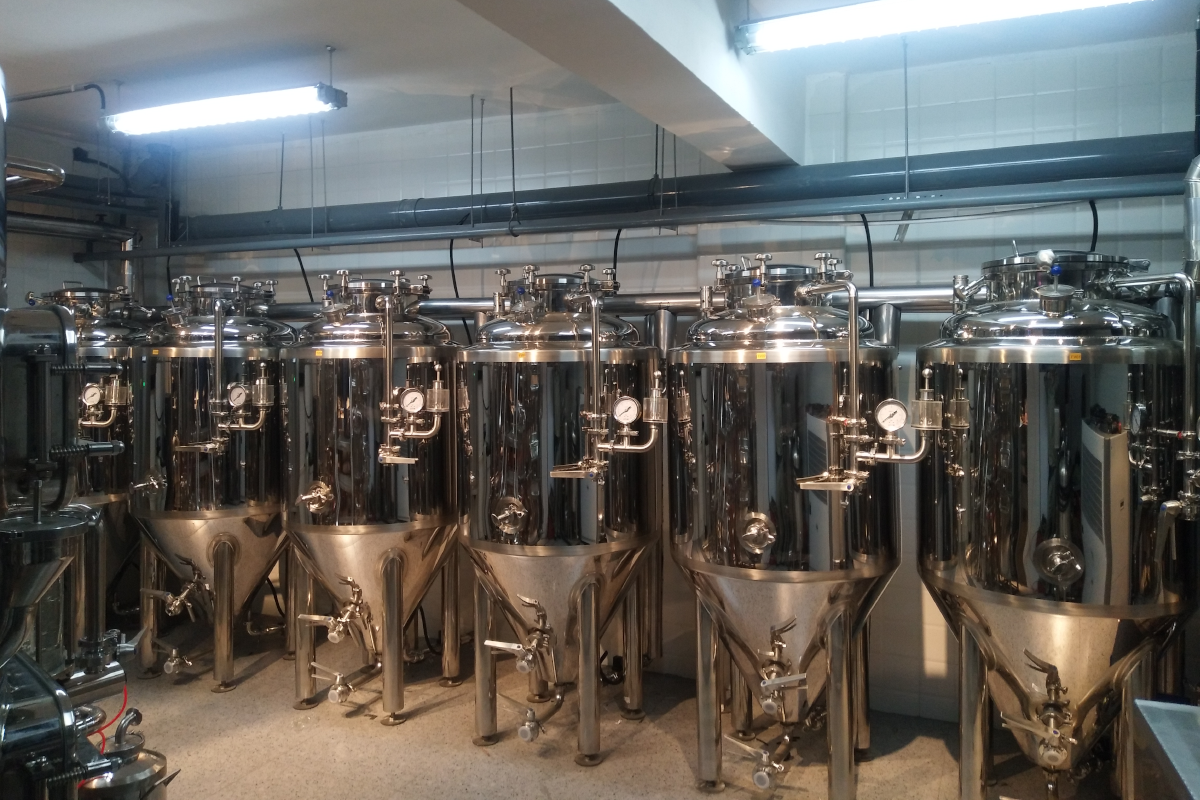
Sizing the Tank
Volume Considerations
The volume of a fermentation tank directly influences the capacity of the brewery and the efficiency of the fermentation process. Selecting the right tank volume involves balancing several factors:
- Batch Size: The first step in determining the tank size is to consider the typical batch size the brewery plans to produce. The tank should be large enough to accommodate the entire batch with some headspace for foam and gas expansion during fermentation.
- Headspace: It’s important to account for additional space at the top of the tank to manage krausen (foam created during fermentation) and to allow for gas exchange. Typically, this means sizing the tank to hold around 10-20% more than the actual batch volume.
- Fermentation Time: The length of time that a batch will remain in the tank also impacts the required volume. Longer fermentation times may necessitate more tanks or larger tanks to maintain continuous production without bottlenecks.
- Product Mix: Breweries producing a variety of beer styles may need tanks of different sizes to accommodate varying batch volumes and fermentation requirements. Smaller tanks might be used for specialty brews or seasonal products, while larger tanks handle the brewery’s core offerings.
- Production Capacity: The overall production capacity of the brewery, including future goals, should be a guiding factor in determining tank volume. It’s essential to consider not just current needs but also potential increases in demand.
Scalability
Scalability is a vital aspect of tank design, particularly for growing breweries that anticipate an increase in production over time. The design and installation of fermentation tanks should allow for easy expansion without disrupting existing operations.
- Modular Systems: One approach to scalability is using modular tank systems. These systems allow breweries to add more tanks as needed, increasing capacity in a controlled and manageable way. Modular designs also offer flexibility in terms of tank size and configuration.
- Future-Proofing: When designing the layout of fermentation tanks, it’s wise to leave space for additional tanks or larger replacements. Planning for expansion from the outset can save time and costs associated with retrofitting or redesigning the brewery later.
- Tank Utilization: Efficient use of tank space is critical for scalability. This includes optimizing the tank’s fill rate and ensuring that tanks are neither underutilized nor pushed to their limits, which could compromise product quality.
- Interconnectivity: Designing tanks with interconnectivity in mind can also enhance scalability. This includes planning for shared utilities like glycol lines for cooling, CO2 lines, and CIP (Clean-in-Place) systems, which can be extended to new tanks as the brewery expands.
- Versatility: Selecting tanks that can be used for multiple stages of production—such as both fermentation and conditioning—can increase flexibility and scalability. This approach allows breweries to adapt to changing production needs without requiring significant new investments.
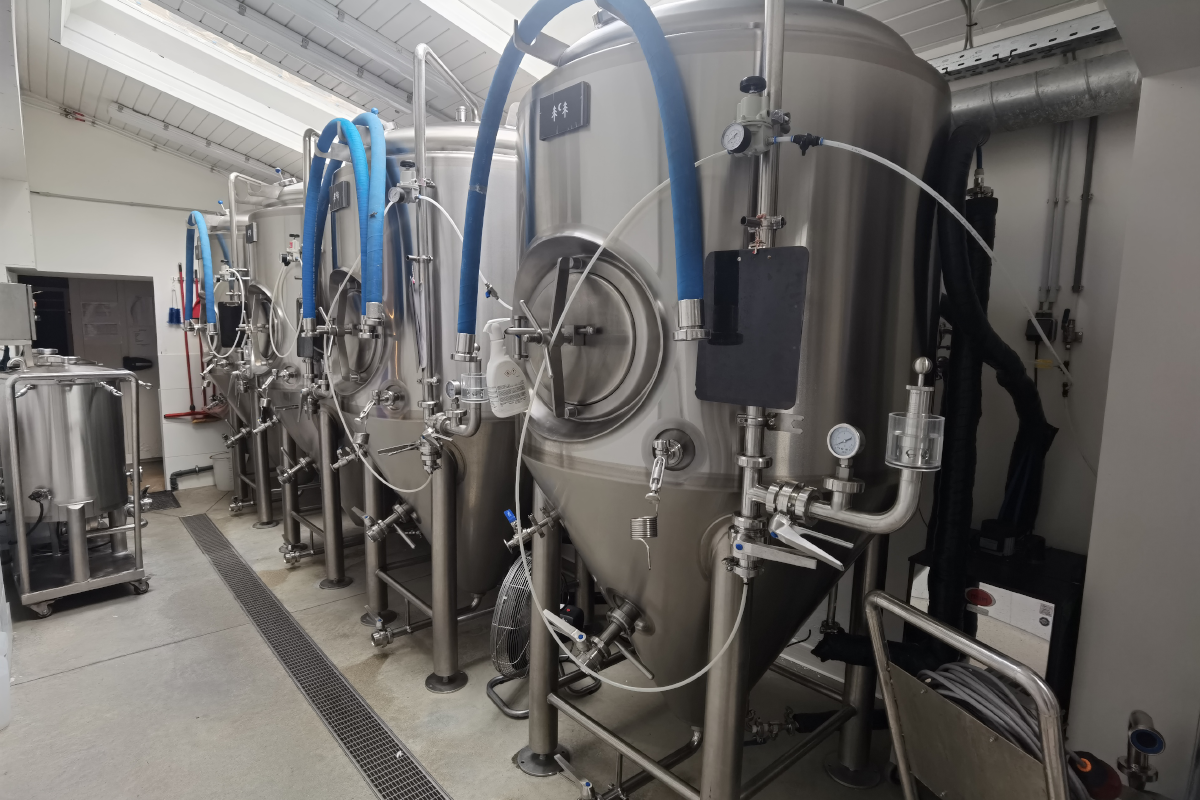
Temperature Control
Cooling Jackets
Cooling jackets are an integral part of fermentation tank design, providing a method to regulate the temperature within the tank by circulating coolant around the vessel.
- Design and Functionality: Cooling jackets are typically installed around the tank’s exterior and can cover the entire height or specific zones, depending on the level of control required. The jacket allows for the circulation of glycol or another coolant, which absorbs heat from the fermenting liquid, maintaining the desired temperature.
- Zonal Cooling: For larger tanks, zonal cooling is often used, where different sections of the tank can be cooled independently. This approach is particularly useful in managing temperature gradients that can occur in large volumes, ensuring uniform fermentation throughout the tank.
- Efficiency: Cooling jackets are highly efficient, providing consistent temperature control with minimal energy consumption. They are also flexible, allowing for quick adjustments in temperature as needed during different stages of fermentation.
- Customization: Depending on the brewery’s specific needs, cooling jackets can be customized in terms of surface area, thickness, and the type of coolant used. This customization ensures that the cooling system aligns perfectly with the fermentation requirements.
Insulation
Insulation is another critical component of temperature control, helping to maintain the desired temperature within the fermentation tank by reducing heat exchange with the external environment.
- Material Choices: Insulation materials typically include polyurethane foam, fiberglass, or mineral wool, which are chosen for their high thermal resistance and durability. The choice of material depends on factors such as the brewery’s climate, the temperature ranges required, and cost considerations.
- Energy Efficiency: Proper insulation minimizes the energy required to heat or cool the fermentation tank, resulting in cost savings and more sustainable operations. By reducing the impact of external temperature fluctuations, insulation helps maintain consistent fermentation conditions.
- Application: Insulation is usually applied to the entire exterior of the tank, including the top and bottom, to prevent any thermal bridges that could lead to temperature inconsistencies. In some cases, an additional layer of stainless steel or aluminum cladding is used to protect the insulation and provide a clean, finished appearance.
- Hygiene and Maintenance: Insulated tanks must be designed to ensure that the insulation does not harbor moisture or bacteria, which could compromise hygiene. High-quality insulation and proper installation techniques can help prevent such problems.
Temperature Monitoring
Accurate temperature monitoring ensures that the fermentation process remains within the optimal temperature range, which directly affects the quality and consistency of the final product.
- Sensors and Probes: Modern fermentation tanks are equipped with temperature sensors or probes that are strategically placed within the tank to monitor the temperature of the fermenting liquid. These sensors provide real-time data, allowing brewers to make precise adjustments to the cooling system.
- Automation: Many breweries integrate temperature monitoring with automated control systems that can adjust the cooling jackets or heaters based on the sensor data. This automation ensures that the fermentation process remains stable without the need for constant manual intervention.
- Data Logging: Advanced temperature monitoring systems often include data logging capabilities, which record temperature readings over time. This data can be invaluable for analyzing fermentation performance, identifying trends, and making informed decisions about future batches.
- Redundancy: To ensure reliability, particularly in large-scale operations, it’s advisable to have redundant temperature monitoring systems in place. This redundancy minimizes the risk of temperature fluctuations due to sensor failure or other issues, protecting the quality of the brew.
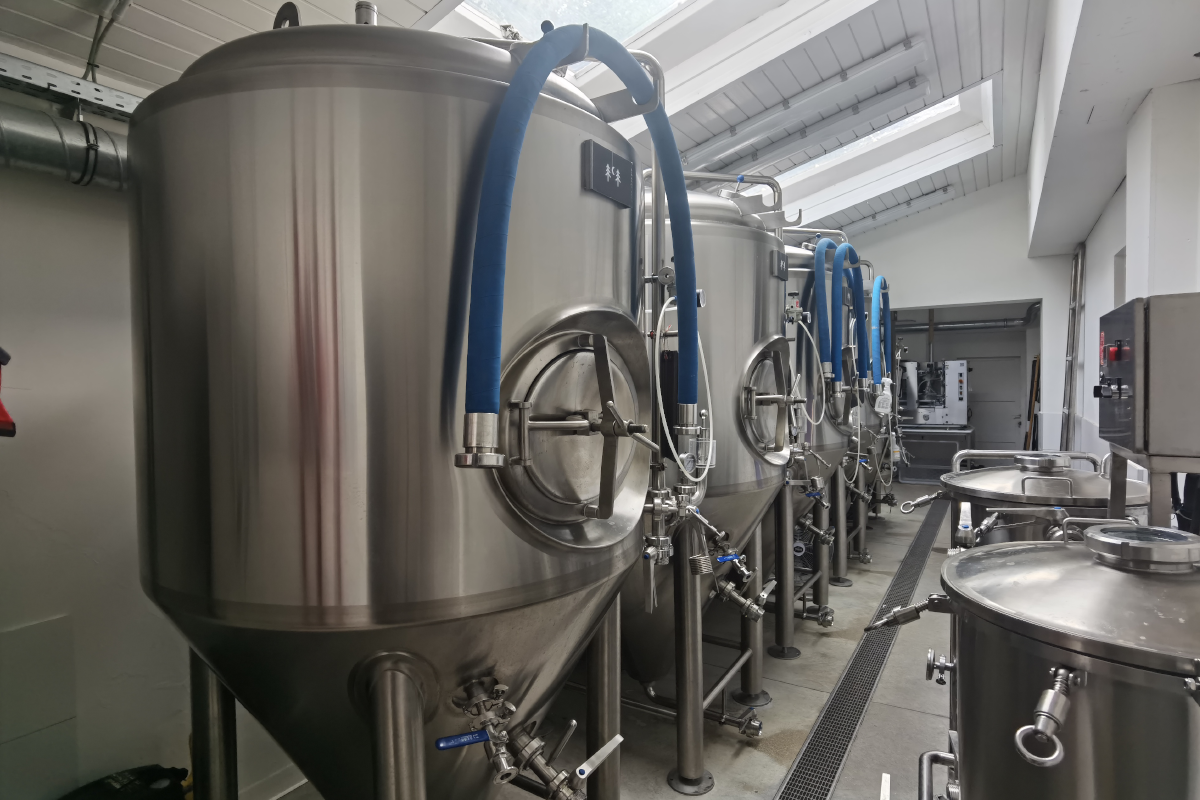
Tank Features
Manways and Access Ports
Manholes and inspection hatches provide access to the fermentation tank for maintenance, inspection, and cleaning.
- Manways: These are larger openings, typically oval or circular, designed to allow personnel to enter the tank for inspection or cleaning purposes. Manways are strategically placed, often on the side or top of the tank, depending on the tank’s design and the specific needs of the brewery. The placement ensures easy access while maintaining the tank’s structural integrity.
- Access Ports: Smaller than manways, access ports allow for the insertion of tools, sensors, or sampling devices without requiring full entry into the tank. They are typically fitted with secure, sanitary closures that can be easily opened and sealed as needed.
- Sealing Mechanisms: Both manways and access ports are equipped with gaskets and clamps to ensure a tight seal, preventing contamination and ensuring the tank remains airtight during fermentation. The materials used for these seals must be food-grade and resistant to the chemicals used in cleaning and sanitization.
- Ease of Use: Manholes and access hatches are designed for easy operation and feature handles or levers for quick opening and closing. This minimizes downtime during maintenance and ensures efficient operation.
CIP (Clean-In-Place) Systems
Clean-in-Place (CIP) systems are a crucial feature in fermentation tank design, allowing for automated cleaning and sanitization of the tank’s interior without disassembly.
- Automated Cleaning: CIP systems automate the cleaning process by circulating cleaning solutions, such as caustic soda, acids, and sanitizers, through spray balls or nozzles inside the tank. This ensures thorough cleaning of all internal surfaces, including hard-to-reach areas, without requiring manual scrubbing.
- Spray Balls and Nozzles: The spray balls or nozzles are placed and designed to achieve complete coverage during the cleaning process. These devices are typically mounted on the top or side of the tank and are designed to deliver high-pressure jets of cleaning solutions that cover all internal surfaces.
- Sanitization: After the cleaning cycle, the CIP system typically includes a sanitization phase, where the tank is flushed with a sanitizing agent to eliminate any remaining microorganisms. This step not only keeps the brewing process hygienic, it also ensures the quality of the final product.
- Integration with Control Systems: Modern CIP systems can be integrated with the tank’s control systems, allowing for automated scheduling of cleaning cycles, monitoring of cleaning parameters, and logging of cleaning data. This integration helps ensure consistent cleaning performance and adherence to hygiene standards.
Agitators and Mixers
Agitators and mixers are used in fermentation tanks to ensure uniformity within the tank, particularly in processes where consistent mixing of the contents is required.
- Purpose: Agitators and mixers are essential for maintaining homogeneity in the fermentation process. They ensure that yeast and other microorganisms are evenly distributed throughout the tank, that nutrients are uniformly available, and that temperature gradients are minimized.
- Types of Agitators: There are various types of agitators used in fermentation tanks, including:
- Propeller Agitators: These are commonly used for low-viscosity liquids and are effective in creating axial flow, which circulates the liquid throughout the tank.
- Turbine Agitators: These agitators are suitable for medium-viscosity liquids and are designed to create radial flow, which is effective in dispersing gases or solids within the liquid.
- Paddle Agitators: Used for high-viscosity liquids or when gentle mixing is required, paddle agitators move the liquid with minimal shear force.
- Variable Speed Control: Many agitators and mixers are equipped with variable speed controls, allowing brewers to adjust the mixing intensity based on the specific stage of fermentation or the type of product being produced.
- Placement and Design: The placement of agitators is crucial for effective mixing. They are typically mounted on the top or side of the tank, with careful consideration given to the tank’s geometry and the desired flow patterns.
- Maintenance: Agitators and mixers must be designed for easy maintenance, with components that can be easily accessed, cleaned, or replaced without disrupting the fermentation process.
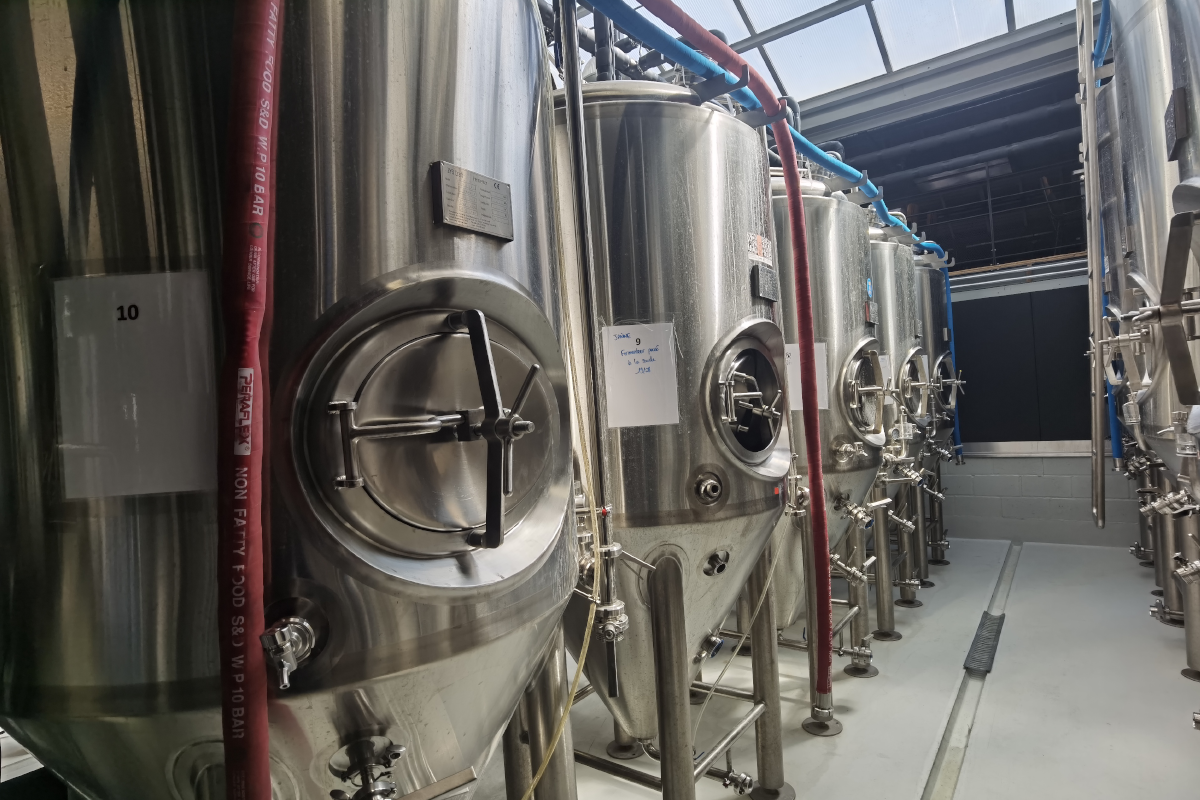
Safety Considerations
Structural Integrity
The structural integrity of a fermentation tank is the foundation of its safety. The tank must be designed and constructed to withstand the pressures and stresses encountered during fermentation, as well as any external forces that could compromise its stability.
- Material Strength: The choice of materials, typically high-grade stainless steel, is crucial for maintaining structural integrity. The material must be strong enough to handle internal pressures, temperature fluctuations, and any mechanical stress without deforming or failing.
- Welding and Construction: High-quality welding ensures that the joints and seams of the fermentation tanks are strong and able to withstand pressure. Tanks are often inspected using non-destructive testing methods, such as X-ray or ultrasonic testing, to verify the integrity of the welds.
- Pressure Ratings: Tanks should be designed with appropriate pressure ratings based on the maximum pressure expected during fermentation. This includes considering any pressure increases due to gas production, thermal expansion, or external factors.
- Reinforcements: Depending on the size and intended use of the tank, additional reinforcements may be necessary, such as stiffening rings or thicker walls at critical points. These reinforcements help distribute stress evenly and prevent localized failures.
Safety Valves and Sensors
Safety valves and sensors are critical components that help monitor and control the conditions within the fermentation tank, preventing unsafe operating conditions.
- Pressure Relief Valves: These valves are designed to automatically release excess pressure from the tank if it exceeds a predetermined limit, preventing the risk of tank rupture or explosion. They are a vital safety feature in any pressure-rated fermentation tank.
- Temperature Sensors: Accurate temperature monitoring is essential to prevent overheating or excessive cooling, which could compromise the fermentation process or lead to safety hazards. Sensors should be placed at strategic points within the tank to provide real-time data on temperature conditions.
- Pressure Sensors: These sensors monitor the internal pressure of the tank, providing continuous feedback to the control system. If the pressure approaches unsafe levels, the system can trigger alarms or automatically activate pressure relief mechanisms.
- Alarm Systems: Integrated alarm systems connected to the sensors can alert operators to any deviations from safe operating conditions. These alarms provide an additional layer of safety, ensuring that issues are addressed promptly before they escalate.
Compliance with Standards
Compliance with industry standards is a fundamental aspect of fermentation tank design, ensuring that the tanks meet regulatory requirements and best practices for safety.
- ASME Standards: Pressure vessels need to comply with the ASME (American Society of Mechanical Engineers) Boiler and Pressure Vessel Code. This standard outlines the design, construction, and testing requirements for pressure-rated tanks, ensuring they can safely handle the stresses of operation.
- Food and Beverage Standards: In the brewing industry, tanks must also comply with food safety standards, such as those set by the FDA (Food and Drug Administration) or European Union regulations. These standards govern the materials used, cleaning protocols, and overall design to ensure the tanks are suitable for food and beverage production.
- CE Marking: In regions like Europe, fermentation tanks may require CE marking, indicating that the equipment meets the relevant health, safety, and environmental protection standards. This certification is particularly important for tanks that will be used in international markets.
- Environmental Regulations: Compliance with environmental regulations is also crucial, particularly regarding waste management and emissions. The design of the tank should consider these factors, ensuring that the brewery operates sustainably and within legal guidelines.
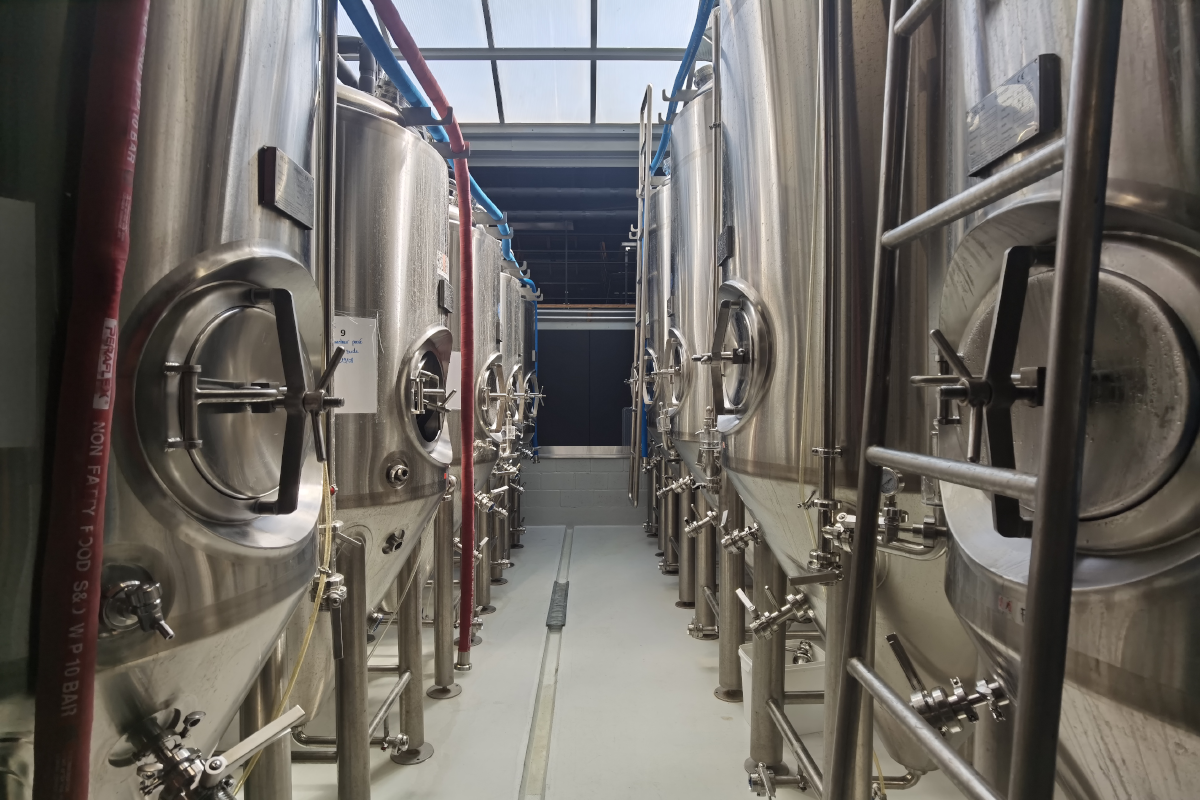
Customization Options
Branding and Aesthetics
In the craft brewing industry, the appearance of fermentation tanks can play a significant role in branding and marketing. Customizing the aesthetics of fermentation tanks offers breweries a way to visually reinforce their brand identity and create a distinctive, memorable brewing environment.
- Custom Finishes: Breweries can choose from a variety of finishes, including polished stainless steel, brushed textures, or even colored coatings. These finishes can enhance the visual appeal of the tanks and align with the overall design theme of the brewery.
- Logo and Branding Elements: Customization options include the ability to incorporate the brewery’s logo or other branding elements directly onto the tanks. This can be done through laser etching, embossed metal plates, or custom paint jobs. Branded tanks not only contribute to a cohesive brand image but also serve as a point of pride and marketing within the brewery, especially in facilities with public tours or taprooms.
- Tank Shape and Design: While functionality is paramount, the shape and design of the tank can also be customized to reflect the brewery’s unique style. This could include non-standard shapes, decorative features, or even custom manways and access ports that complement the brewery’s aesthetic.
- Lighting and Presentation: Incorporating lighting into the tank design can further enhance the visual impact. LED lights, for example, can be installed around or within the tanks to highlight specific features or create an inviting atmosphere in the brewery.
Specialized Fermentation Processes
Customization goes beyond aesthetics, allowing breweries to optimize their fermentation tanks for specific brewing processes. This ensures that the equipment supports the brewery’s unique production techniques and enhances the quality of the final product.
- Temperature Control Customization: For breweries engaged in producing a wide variety of beer styles, customization of temperature control systems is crucial. This could include advanced zonal cooling capabilities, tailored insulation solutions, or the integration of specialized temperature monitoring and control systems that are fine-tuned for specific fermentation processes.
- Agitation and Mixing Systems: Some breweries may require customized agitation or mixing systems to support specialized fermentation processes, such as spontaneous fermentation or the production of mixed-culture beers. Custom agitators, mixers, or even rousing systems can be designed to ensure that the yeast and other ingredients are evenly distributed, enhancing the consistency and quality of the brew.
- Pressure Management: For breweries that focus on producing high-carbonation beers or engaging in secondary fermentation under pressure, the tank’s pressure management systems can be customized. This could include the integration of specialized pressure relief valves, additional safety features, or custom-designed pressure vessels that meet the specific demands of the brewery’s processes.
- Multi-Use Configurations: Fermentation tanks can also be customized for multi-use functionality, allowing them to serve multiple stages of the brewing process, such as fermentation, conditioning, or even carbonation. This flexibility can be particularly valuable for smaller breweries looking to maximize their equipment investment.
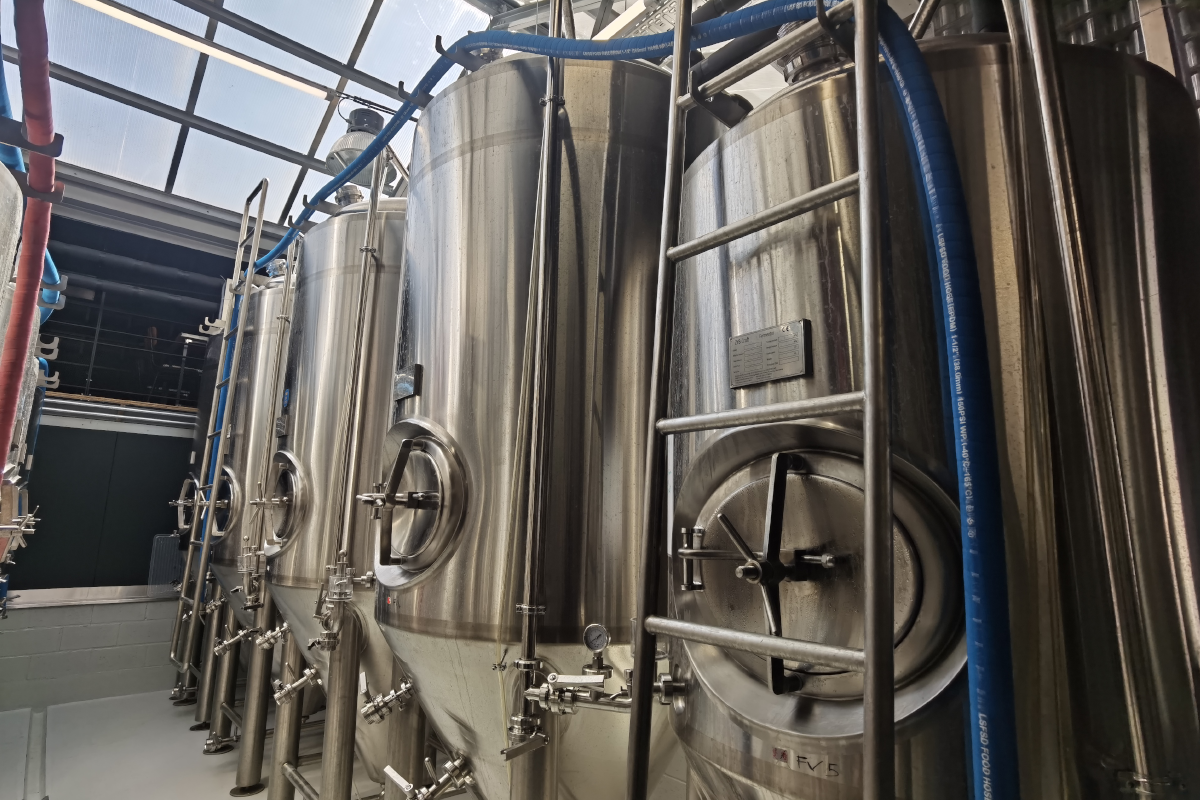
Cost Considerations
Initial Investment
The initial investment in fermentation tanks includes the cost of the tanks themselves, as well as associated expenses such as installation, customization, and any necessary infrastructure upgrades.
- Tank Material and Construction: The choice of materials, such as stainless steel, and the complexity of the tank design significantly influence the initial cost. Higher-grade materials like 316 stainless steel, which offer greater corrosion resistance and durability, tend to be more expensive but may provide long-term value through increased lifespan and reduced maintenance.
- Customization Costs: Custom features, such as specialized finishes, branded elements, or advanced temperature control systems, add to the initial investment. While these customizations enhance functionality and brand identity, they also increase upfront costs.
- Installation and Setup: The cost of installing fermentation tanks includes labor, transportation, and any modifications to the brewery’s infrastructure, such as reinforcing floors or upgrading cooling systems. Proper planning and budgeting for these expenses can avoid unexpected costs during the installation process.
- Scalability Considerations: Investing in modular or scalable tank designs may involve higher initial costs but can reduce future expenses as the brewery expands. Planning for scalability from the outset can provide cost savings in the long run by minimizing the need for significant retrofitting or additional installations.
Operating Costs
Operating costs include the ongoing expenses associated with maintaining and using the fermentation tanks, which impact the overall efficiency and profitability of the brewery.
- Energy Consumption: The energy required to operate temperature control systems, such as cooling jackets and heaters, is a significant operating cost. Tanks that are well-insulated and designed for energy efficiency can help reduce these expenses, contributing to more sustainable operations.
- Maintenance and Cleaning: Regular maintenance and cleaning can help ensure the longevity and performance of your fermentation tank. CIP (Clean-In-Place) systems, while increasing initial investment, can reduce operating costs by streamlining cleaning processes and minimizing downtime.
- Labor Costs: The ease of use and accessibility of fermentation tanks can influence labor costs. Tanks that are designed for easy access, monitoring, and maintenance can reduce the time and effort required by brewery staff, leading to lower operational costs over time.
- Chemical and Water Usage: The cost of cleaning agents, sanitizers, and water used in the fermentation process should also be considered. Efficient cleaning systems that minimize the use of these resources can lead to cost savings and reduce the environmental impact of the brewery’s operations.
Return on Investment (ROI)
The return on investment (ROI) from fermentation tanks is a key consideration for any brewery looking to justify the costs of new equipment. ROI is influenced by both the initial investment and the ongoing operating costs, as well as the tanks’ impact on production efficiency and product quality.
- Production Efficiency: Tanks that are designed to maximize fermentation efficiency can lead to increased output and reduced production time. This improved efficiency translates into higher revenue potential, contributing to a quicker ROI.
- Product Quality: High-quality fermentation tanks that offer precise temperature control, effective pressure management, and thorough cleaning systems can lead to consistently superior products. Improved product quality can enhance brand reputation, increase customer satisfaction, and lead to higher sales, all of which contribute to ROI.
- Scalability and Future Growth: Investing in tanks that are scalable or modular can provide a better ROI over time, as these tanks can be easily expanded or adapted to meet growing production demands without requiring significant additional investment.
- Market Positioning: Customization options that enhance the visual appeal and branding of the tanks can also contribute to ROI by attracting more customers, particularly in markets where brewery tours and on-site sales are significant revenue streams.
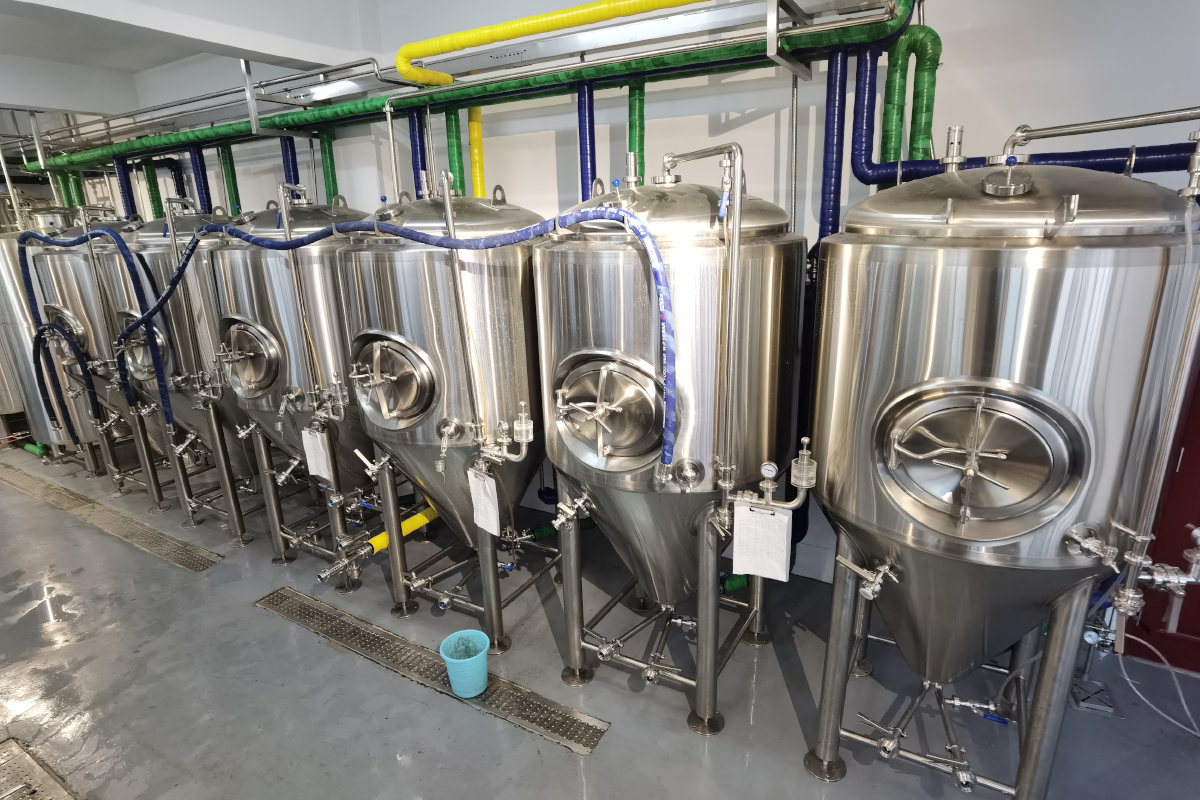
Summary
